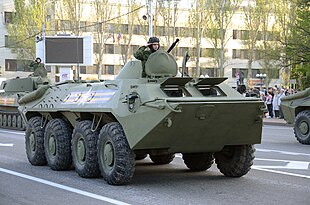BTR-70
| BTR-70 | |
|---|---|

BTR-70 of the United Armed Forces of Novorossiya, 2015
|
|
| Type | Armoured personnel carrier |
| Place of origin | Soviet Union |
| Service history | |
| In service | 1972 - present |
| Specifications | |
| Weight | 11.5 tonnes |
| Length | 7.535 m |
| Width | 2.80 m |
| Height | 2.32 m |
| Crew | 3 (+ 7 passengers) |
|
|
|
| Armor | 9 mm (front) 7 mm (sides) |
|
Main
armament |
14.5 mm KPVT machine gun or 12.7 mm DShK |
|
Secondary
armament |
7.62 mm PKT machine gun |
| Engine | 2× gasoline ZMZ-4905 120 hp (88.2 kW) (×2) |
| Power/weight | 20 hp/tonne |
| Suspension | wheeled 8×8 |
|
Operational
range |
400–600 km |
| Speed | 80 km/h, swim 9 km/h |
The BTR-70 is an eight-wheeled armored personnel carrier (Russian: бронетранспортер/Bronetransporter, or literally "Armoured Transporter") originally developed during the late 1960s under the industrial designator GAZ-4905. On August 21, 1972, it was accepted into service and would later be exported to the Warsaw Pact and other allies. Introduced as a successor to the earlier BTR-60, it most closely resembles a BTR-60PB. Improvements include heavier armor plating and tires less prone to puncture. In other respects, the vehicle is very similar to the BTR-60PB, both vehicles having a roof-mounted turret equipped with a heavy machine gun and a secondary co-axial PKT machine gun, but with a more powerful petrol engine configuration.
Another difference was in the location of the side doors, which on the vehicle's predecessor were located above the beltline between the second and third pairs of wheels on both sides of the vehicle. However, the designers of the BTR-70, moved the doors below the beltline. As Soviet tactics calls for unloading troops from the vehicle while it is in motion, this change increased the risk of a soldier being pulled under a wheel and injured or killed, although it also meant that the troops could get out quicker and expose themselves less to the enemy.
Like the vehicle's predecessor, it is fully amphibious with minimal preparation. A licensed Romanian copy was designated the TAB-77 and had various improvements and changes to make local production easier, including a better turret and different engines.
The BTR-70 is powered by two gasoline engines. Early production vehicles used 115 hp GAZ-69B 6-cylinder engines, but most vehicles have the more powerful ZMZ-49-05 V-8 engines. The vehicle is fully amphibious, propelled when afloat by a single water jet mounted at the rear of the hull. To prepare the vehicle for water, the driver erects a trim vane and switches on the bilge pumps from within the vehicle.
The standard equipment includes a central tire-pressure regulation system that allows the driver to adjust the tire-pressure to suit the terrain being crossed. Also fitted is an R-123M radio set and an R-124 intercom. The driver's optical equipment consists of three TNPO-115 vision blocks and a TNP-B day vision device, which can be replaced by a TVNO-2B night vision device. The commander also has three TNPO-115s and either a TPKU-2B day sight or a TKN-1S night sight accompanied by an OU-3GA-2 infra-red search light. The turret is fitted with a PP-61AM (or 1PZ-2) periscopic sight for the gunner and the infantry group in the troop compartment is provided with TNP-B devices. The BTR-70 also has an FVU NBC filter system and a DK-3B detection device.
...
Wikipedia
